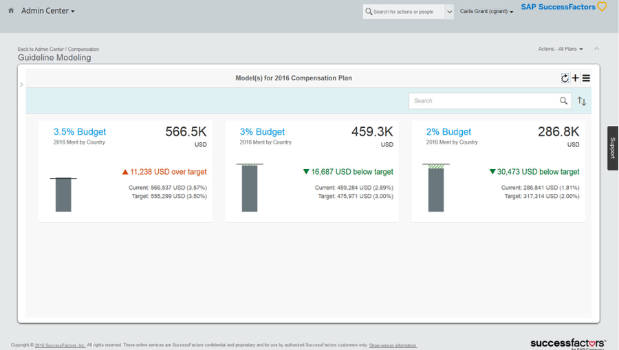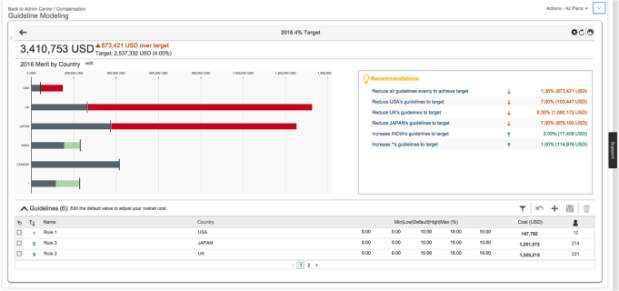With increased global competition for talent, increasing globalization of the workforce and the rapid pace of change in the business environment today, employers are working harder than ever to retain and reward top talent. According to the Workforce 2020 research study, what employees value most is competitive pay. However, although 67% of employees say competitive compensation is important, only 40% of executives say their company widely offer it. So, why is there disparity in what employee’s value and what companies offer?
Despite recognizing the importance competitive compensation plays in attracting and retaining talent, companies are struggling to reward high potentials and key contributors. Having a solid compensation planning model is an important step in retaining key talent by ensuring that employees are being paid competitively while adhering to company budgets. Modeling is a strategic decision-making tool that enables organizations to design effective compensation plans aligned with their financial and HR objectives – which can have a positive impact on an organization’s bottom line.
Providing fine-tuned compensation guidance to Planners is a daunting task. Compensation Teams need to juggle small merit budgets across diverse business units, geographies, employees below the pay range, at risk of loss, high potentials, and multiple pay currencies; the reality is that insufficient modeling by compensation professionals is common, often due to lack of time, lack of expertise or adequate modeling tools.
Compensation modeling is a time consuming task for HR. In fact, nearly three-quarters — 71 percent — of participants in a Ventana report identified Microsoft Excel as a system they use for compensation management. While spreadsheets certainly have a place within many organizations, their use as a compensation management tool can lead to challenges. For starters, it can be easy to inadvertently introduce errors. Few spreadsheets possess the security features needed to safeguard confidential salary and payroll information. Additionally, important compensation plan design decisions are made in geographical or divisional silos because data is not easily available on spreadsheets. Once a compensation plan design has been determined, all the data must be re-created in the compensation management software system to initiate the compensation planning process.
Making the move from Administrative to Strategic Compensation Management with SAP SuccessFactors
Compensation professionals can now spend less time on constructing guideline spending schemes with multiple spreadsheets and more time on strategic activities. Expanding our existing variable pay forecasting and modeling capabilities, compensation professionals using SAP SuccessFactors Compensation can now model base salary, incentive bonus and long-term incentive programs prior to finalizing planning cycle configuration. With the first release of 2016, we’re proud to introduce new and innovative compensation modeling capabilities that improve planning accuracy and efficiency by aligning compensation guidelines with budgets.

Image 1: Guideline modeling homepage
Compensation specialists can now plan and model base pay adjustments and LTI’s (equity and cash) distribution in multiple ways:
- Smart Alignment – We are taking the headache out of compensation modeling. With hundreds or thousands of guidelines, it can be difficult to know the overall guideline cost, or what adjustments need to be made to meet budget targets. SAP SuccessFactors Compensation unique and innovative approach to modeling provides specific recommendations on how the guidelines can be adjusted to align with pre-defined targets. (See image 2)
- Top-down – Organizations can define targets for base pay adjustments or LTI distribution based on salary surveys and the specific situation they are in (for example we pay our engineers 2.5% above market average). Starting with these targets by country, location, position or other parameters compensation specialists can then model the guidelines they need to deploy to reach them.
- Bottom-up – The modeling tool starts with applying previous year’s guidelines to the current eligible population to estimate the baseline expense. The Compensation Specialist can then update the guideline values and attributes using pay relevant criteria such as position in range, rating, job family, location, high potential, salary grade or any custom field.

Image 2: Smart recommendations make it easy to align guidelines with targets
SAP SuccessFactors Compensation modeling allows you to:
- Perform complex calculations and analyze how base salary and equity should be awarded to employees across a variety of criteria including locations, performance levels, and position in range, just to name a few.
- Model the cost of incorporating salary survey information on competitive market increases by country,
industry, and job classification. - Have firm targets in place from a works council, union, or the finance department.
- Measure the financial impact of adjusting pay guides or updating exchange rates.
Some benefits include: - Access to organization-wide data for more holistic planning
- Ability to drill down and roll up at desired level of granularity
- Push the optimal compensation model(s) to a live plan template









